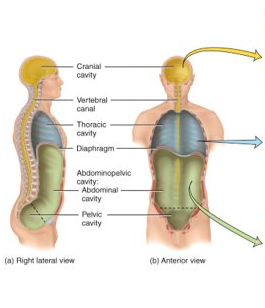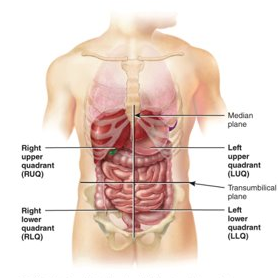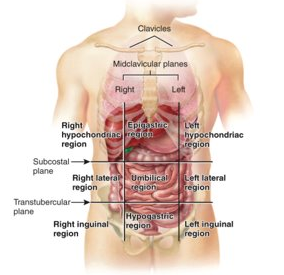Human Anatomy - Chapter 1
5.0(2)
Card Sorting
1/60
Earn XP
Description and Tags
Study Analytics
Name | Mastery | Learn | Test | Matching | Spaced |
|---|
No study sessions yet.
61 Terms
1
New cards
What is anatomy?
the study of body structures and the relationships among structures
2
New cards
What is physiology?
how body parts function
3
New cards
Chemical level?
atoms, the smallest units of matter that participate in chemical reactions, and molecules, two or more atoms
4
New cards
Cells?
basic structural and functional units of an organism
5
New cards
Tissues?
groups of similarly specialized cells and the substances surrounding them that usually arise from a common ancestor and perform certain special functions
6
New cards
Organs?
structures of definite form that are composed of two or more different tissues and have specific functions
7
New cards
Systems?
related organs that have a common function
8
New cards
Organism?
a collection of structurally and functional integrated systems; any living individual
9
New cards
What is the integumentary system?
skin and associated structures: protects body, reg. temps., waste elim., senses things
10
New cards
What is the skeletal system?
bones, joints, and cartilage: support and protection, aids movement, houses cells that produce blood cells
11
New cards
What is the muscular system?
Skeletal muscle tissue: body movement, posture, produce heat
12
New cards
What is the nervous system?
brain, spinal cord, nerves: generates nerve impulses to regulate body activity, detects, interprets, and responds to change
13
New cards
What is the endocrine system?
hormone-producing glands: regulates body activity
14
New cards
What is the cardiovascular system?
blood, heart, blood vessels: carries oxygen and nutrients to cells, takes waste products away, helps regulate temps, acid-base balance, and water, helps defend, repairs damaged blood vessels
15
New cards
What is the lymphatic system & immunity?
lymphatic fluid, vessels, spleen, thymus, lymph nodes, tonsils: returns proteins and fluid to blood, carries fat from tract to blood, maturation and proliferation of B and T cells that protect against microbes
16
New cards
What is the respiratory system?
lungs and air passageways: transfers oxygen to blood, transfers CO2 from blood out, helps regulate acid-base balance, produces voice
17
New cards
What is the digestive system?
mouth, pharynx, esophagus, stomach, small and large intestines, anus, salivary glands, liver, gallbladder, pancreas: physical and chemical breakdown of food, absorbs nutrients, elim. solid waste
18
New cards
What is the urinary system?
kidneys, ureters, urinary bladder, urethra: produce, store, elim. urine, elim. waste, regulates volume and chem. comp. of blood, helps maintain acid-base balance, maintains mineral balance, regulates production of rbc
19
New cards
What is the reproductive system?
gonads and associated organs: produce gametes, release hormones, regulate reproduction, produce milk
20
New cards
What is inspection?
examiner observes the body
21
New cards
What is palpation?
examiner feels body surface with hands
22
New cards
What is auscultation?
examiner listens to body sounds
23
New cards
What is percussion?
examiner taps on body with fingers and listens for echo
24
New cards
What are the basic life processes?
metabolism, responsiveness, movement, growth, differentiation, and reproduction
25
New cards
What is metabolism?
sum of all chemical processes that occur in the body
26
New cards
What is responsiveness?
ability to respond to changes
27
New cards
What is movement?
motion of anything related to body (organs, cells, etc.)
28
New cards
What is growth?
an increase in size and complexity
29
New cards
What is differentiation?
cell goes from unspecialized to specialized
30
New cards
What is reproduction?
formation of new cells or production of new individual
31
New cards
What is homeostasis?
a condition of equilibrium in the body's internal environment
32
New cards
What is the fluid that helps our body cells survive?
extracellular fluid
33
New cards
Where can ECF be found?
it is found throughout the whole body but has many different names such as plasma (blood vessels), lymph (lymphatic vessels), cerebrospinal fluid (brain and spinal cord), etc.
34
New cards
What is a stimulus?
any disruption that changes a controlled condition
35
New cards
What is a feedback system?
a cycle of events in which information of the condition is continually monitored and reported to a central control region
36
New cards
What are the 3 basic components of a feedback system?
receptor (monitors changes and sends input to control center), control center (sets range of values within controlled condition that should be maintained, evaluates input from receptor, generates output), and effector (receives output from control center and produces a response that changes controlled condition)
37
New cards
What is the difference between a negative and positive feedback system?
negative reverses stimulus while positive enhances stimulus
38
New cards
Give an example of a negative feedback system.
Stress (stimulus) causes bp to rise (controlled condition), baroreceptors send impulses (input) to the brain (control center) which then send impulses to the heart (effector) to decrease hr, returning to normal bp (homeostasis)
39
New cards
Give an example of a positive feedback system.
uterus stretches (stimulus) and stretch-sensitive nerves (receptors) in the cervix sends impulses (input) to the hypothalamus (control center) which causes oxytocin (output) to release and stimulates the uterus (effector) to contract more forcefully (response), cycle breaks with birth
40
New cards
What is a disorder?
any abnormality of structure or function
41
New cards
What is a disease?
(local, systemic) a more specific term for an illness characterized by a recognizable set of signs (observed and measured) and symptoms (subjective not measurable, told by patient)
42
New cards
What is anatomical position?
standardized method of observing the body that allows precise and consistent anatomical reference. person stands erect, facing forward, arms by side, palms forward, feet flat on floor
43
New cards
What are the 13 directional terms?
superior (toward head), inferior (away from head), anterior (near front), posterior (near back), medial (near midline), lateral (farther from midline), intermediate (between two structures), ipsilateral (same side of body as another structure), contralateral (opposite side of body as another structure), proximal (near to attachment point of trunk), distal (farther from attachment point of trunk), superficial (toward surface), and deep (away from surface).
44
New cards
What are the planes of the body?
Coronal/frontal (front and back), transverse (upper and lower), median/midsagittal (left and right), paramedian/sagittal (left and right but not directly on midline)
45
New cards
What are the 7 (9) body cavities?
cranial (brain), vertebral (spinal cord), thoracic (chest): pleural (lungs), pericardial (heart), and mediastinum (heart, thymus, esophagus, trachea), abdominopelvic (abdomen and pelvis): abdominal (stomach, spleen, liver, gallbladder, small and large intestines) and pelvic (urinary bladder, part of large intestine, internal organs of reproduction)

46
New cards
What is serous membrane?
a thin, double-layered membrane that covers the viscera within the thoracic and abdominal cavities.
47
New cards
What are the parts of the serous membrane?
the visceral layer (adheres to the viscera within the cavities) and the parietal layer (lines the walls of the cavities) also contains serous fluid between the two to reduce friction

48
New cards
What is the serous membrane of the lungs?
pleural membrane with the visceral pleura attached to the surface of the lungs and the parietal pleura attached to the chest wall
49
New cards
What is the serous membrane of the heart?
pericardium with the visceral pericardium covering the surface of the heart and the parietal pericardium lining the chest wall
50
New cards
What is the serous membrane of the abdominal cavity?
peritoneum with the visceral peritoneum covering the abdominal viscera and the parietal peritoneum lining the abdominal wall
51
New cards
What is a retroperitoneal and what is an example of it?
the organs that are not surrounded by the peritoneum and are posterior to it. an example is the kidneys, pancreas, etc.
52
New cards
What are the four quadrants of the abdominopelvic cavity?
right upper, left upper, right lower, and left lower

53
New cards
What are the nine regions of the abdominopelvic cavity?
right hypochondriac, epigastric, left hypochondriac, right lateral, umbilical, left lateral, right inguinal, hypogastric, and left inguinal

54
New cards
What is a radiography?
radiography (x-rays): inexpensive, quick, and simple, does not pass easily through dense structures so bones appear white while hollow structures appear black. sometimes use of a substance called contrast medium is necessary to make structures visible. contrast x-rays are mainly used to image blood vessels, urinary system, and gastrointestinal tract
55
New cards
What is a MRI?
MRI (magnetic resonance imaging): exposed to high-energy magnetic fields which cause protons to arrange themselves in relation the to field. safe but cannot be used on those with metal in body, shows fine details for soft tissues but not for bones. used to detect tumors and artery-clogging, reveal brain abnormalities, measure blood flow, and detect musculoskeletal, liver, and kidney disorders
56
New cards
What is a CT scan?
CT (computer tomography): x-ray beam traces an arc at multiple angles around a section. visualizes soft tissues and organs with more detail then normal radiographs. multiple scans can create 3d imaging. typically target torso and appears to provide screening for lung cancer, coronary artery disease, and kidney cancer.
57
New cards
What is an ultrasound?
Ultrasound: high frequency sound waves. safe and non-invasive. used to visualize fetus and observe size, location, and actions of organs and blood flow.
58
New cards
What is a CCTA scan?
CCTA (cardiac computed tomography angiography): iodine-contract medium and beta-blocker used to decrease hr. x-ray beams trace an arc around the heart and transform information into a 3d image of the coronary blood vessels. used to determine coronary artery blockages.
59
New cards
What is a PET scan?
PET (positron emission tomography): positrons injected into body, collision of positrons with negatively charged electrons produces gamma rays that are detected by gamma cameras. Used to study the physiology of body structures, such as metabolism in the brain and heart
60
New cards
What is an endoscopy?
Endoscopy: visual examination of the inside of body organs or cavities with a lighted instrument with lenses (endoscopes).
61
New cards
What is a radionuclide scanning?
Radionuclide scanning: a radioactive substance is carried by the blood to the tissue to be imaged. gamma rays are detected by and read by gamma cameras. used to study activity of a tissue or organ, such as searching for malignant tumors in body tissue or scars that may interfere with heart muscle activity.